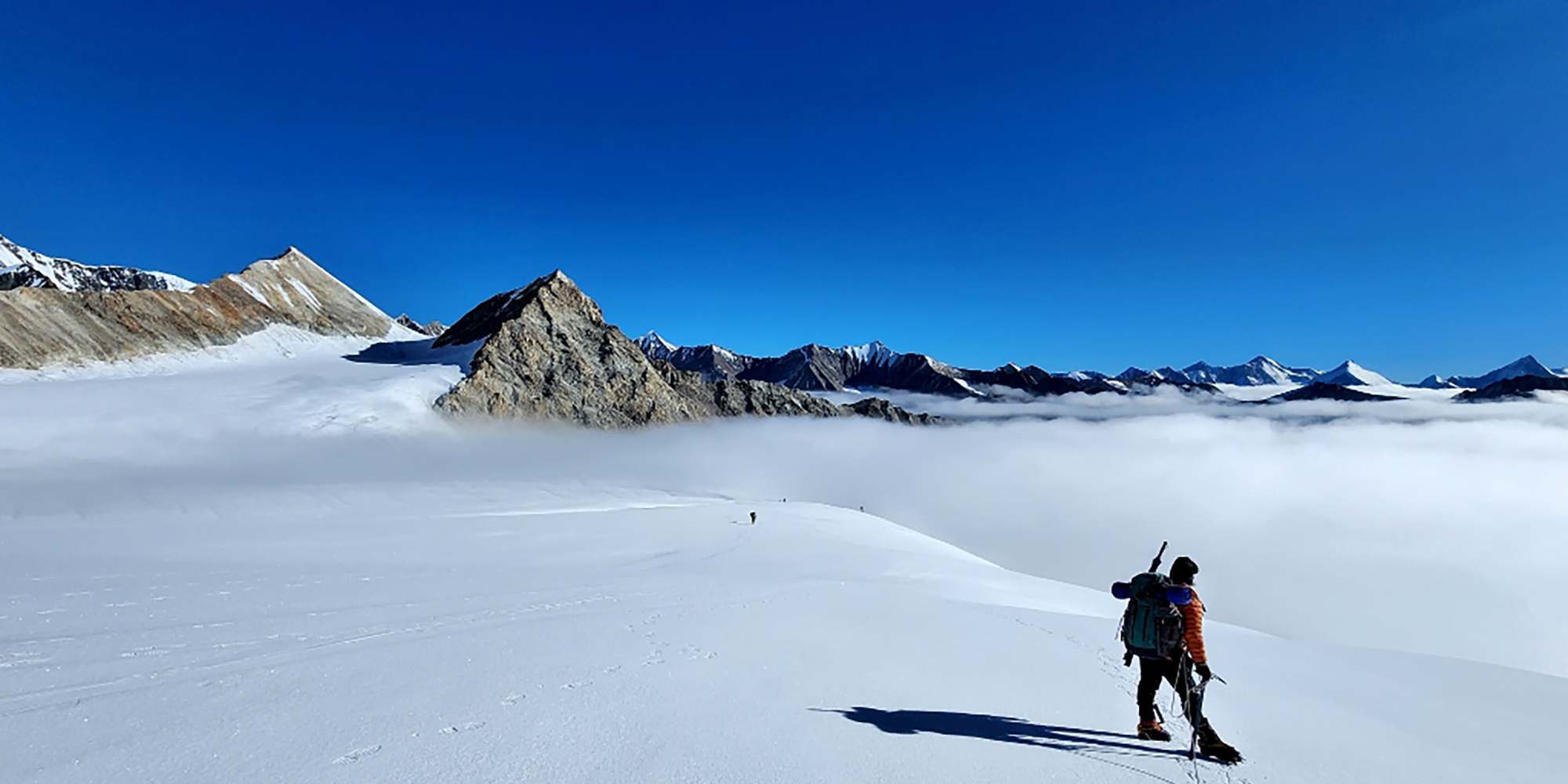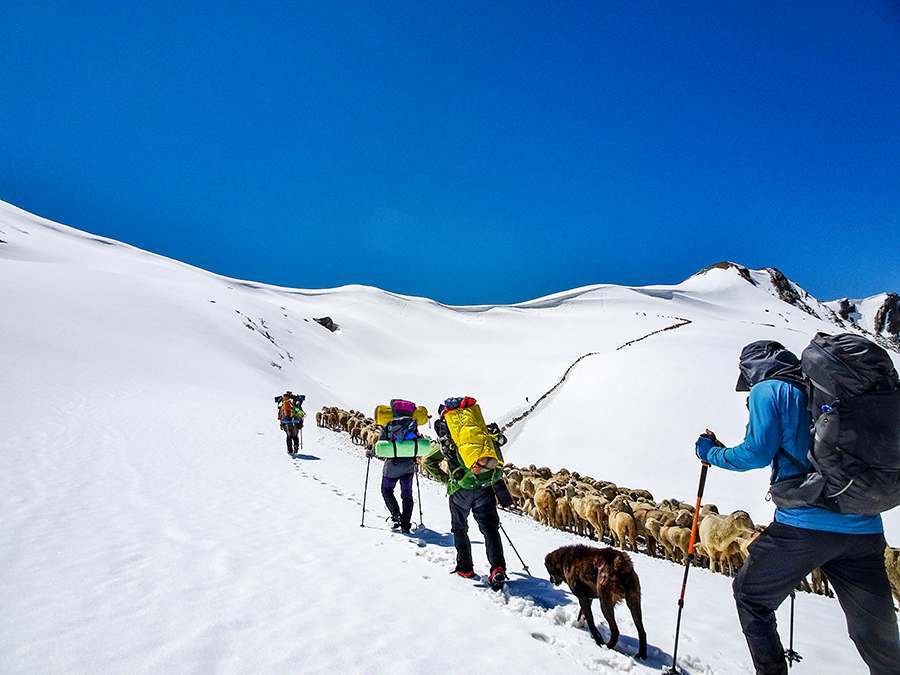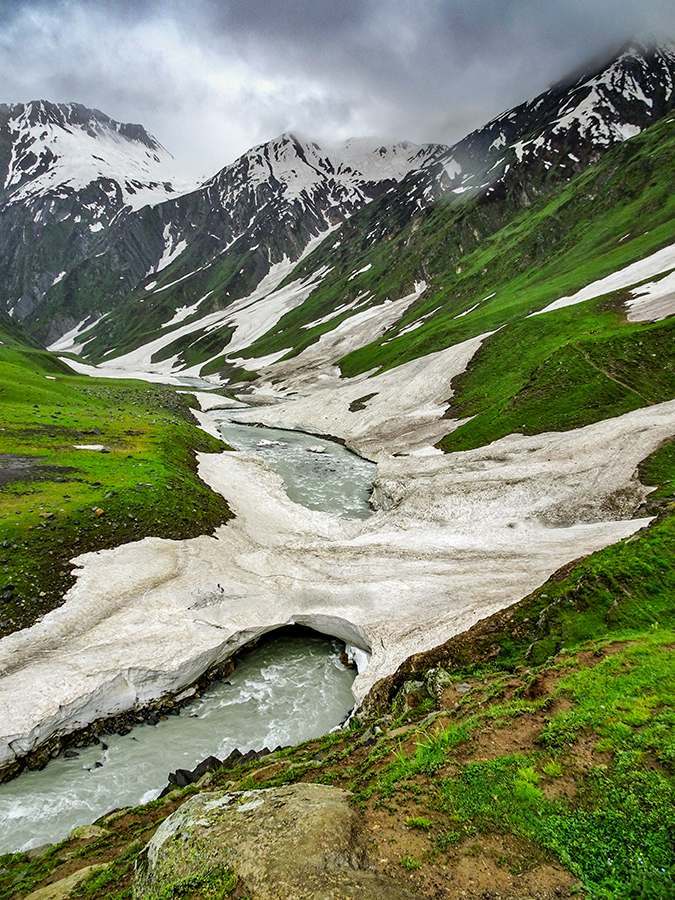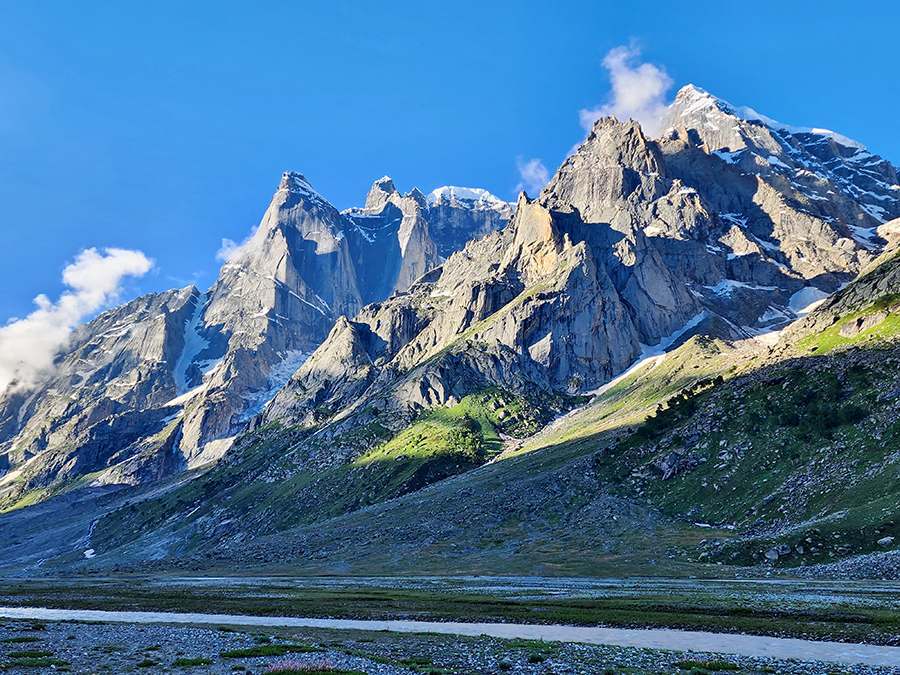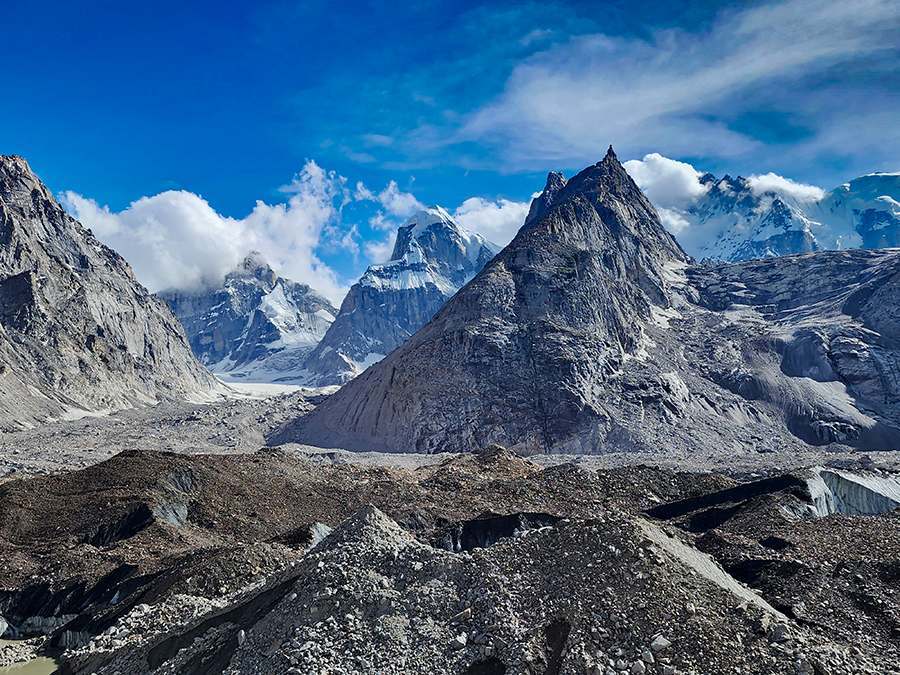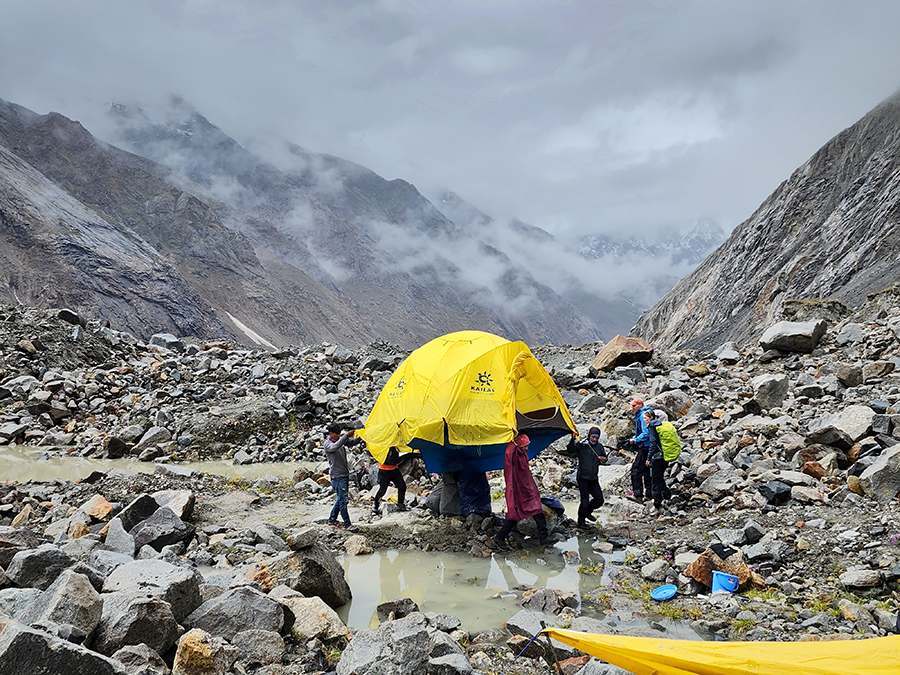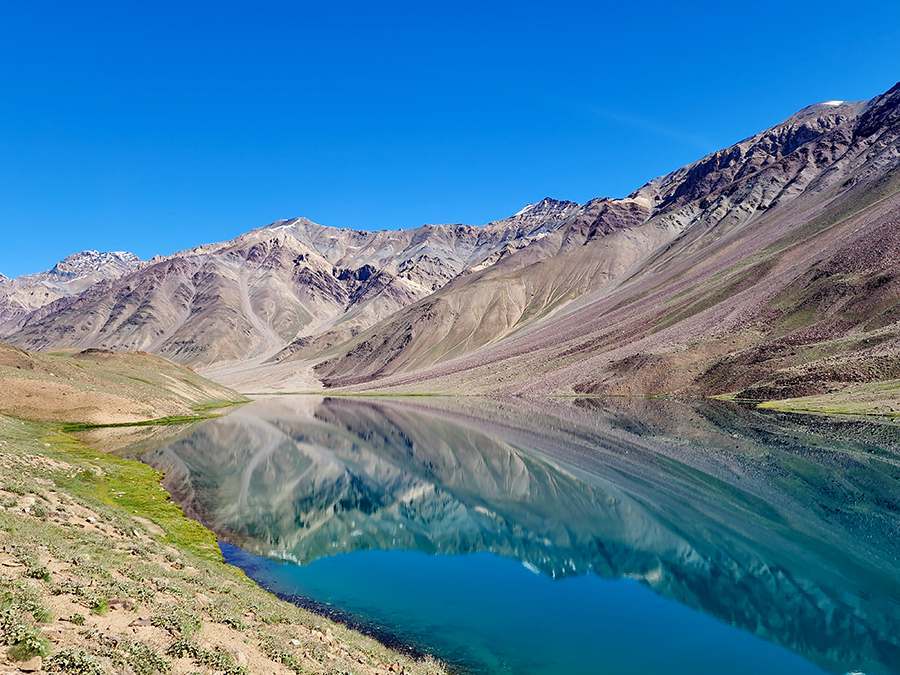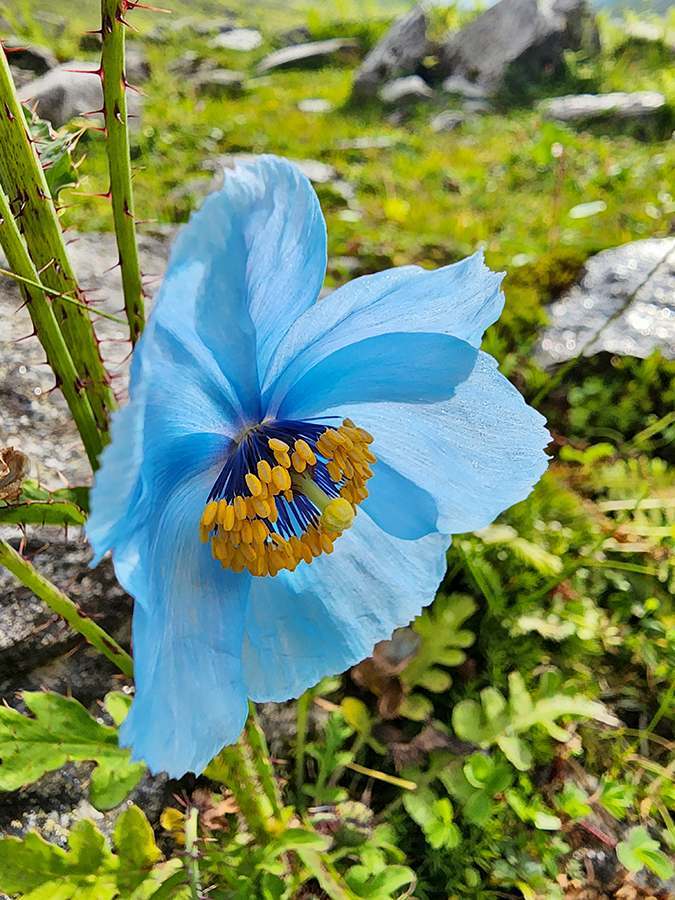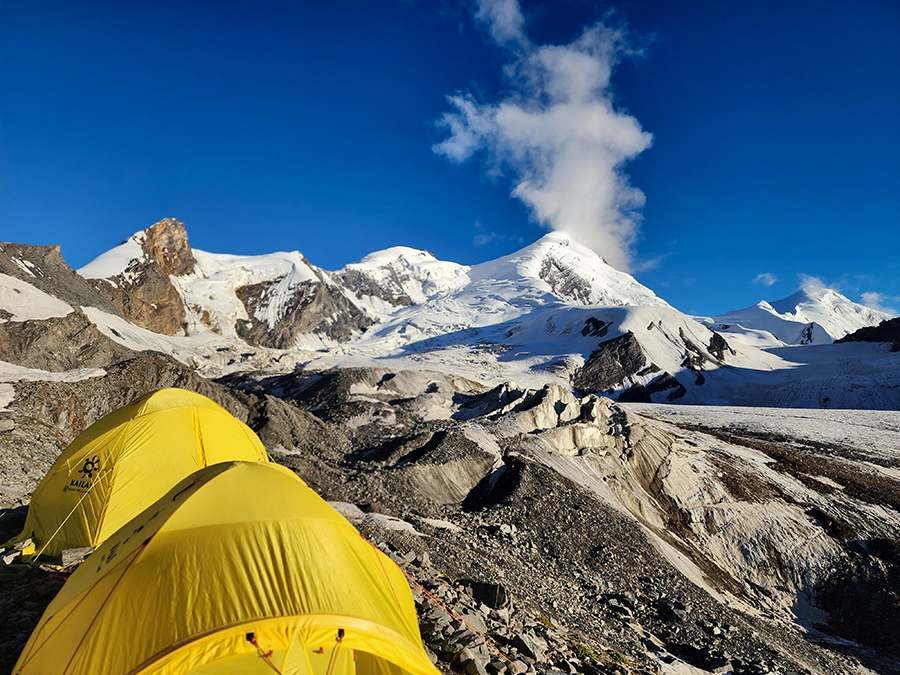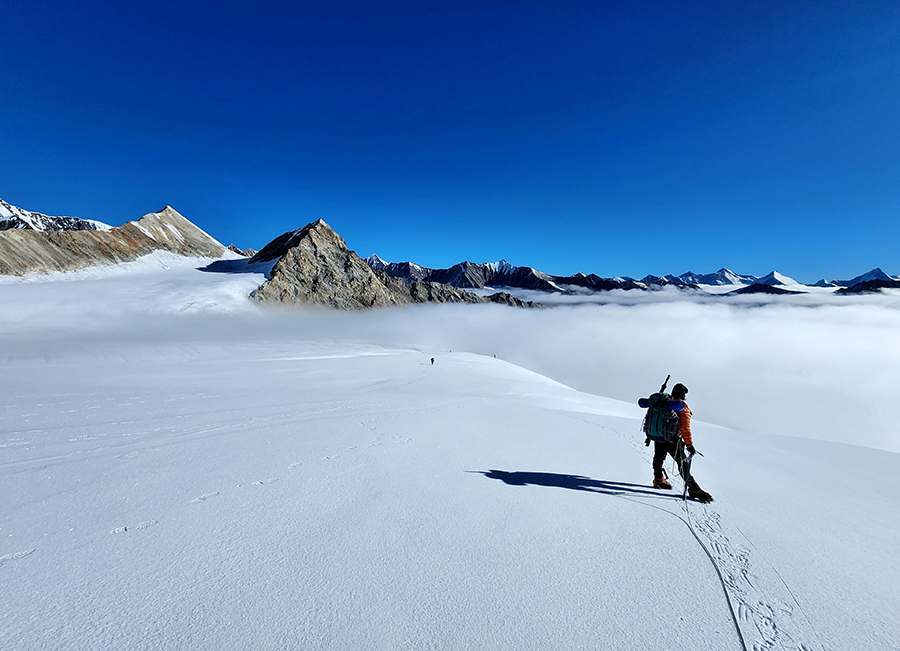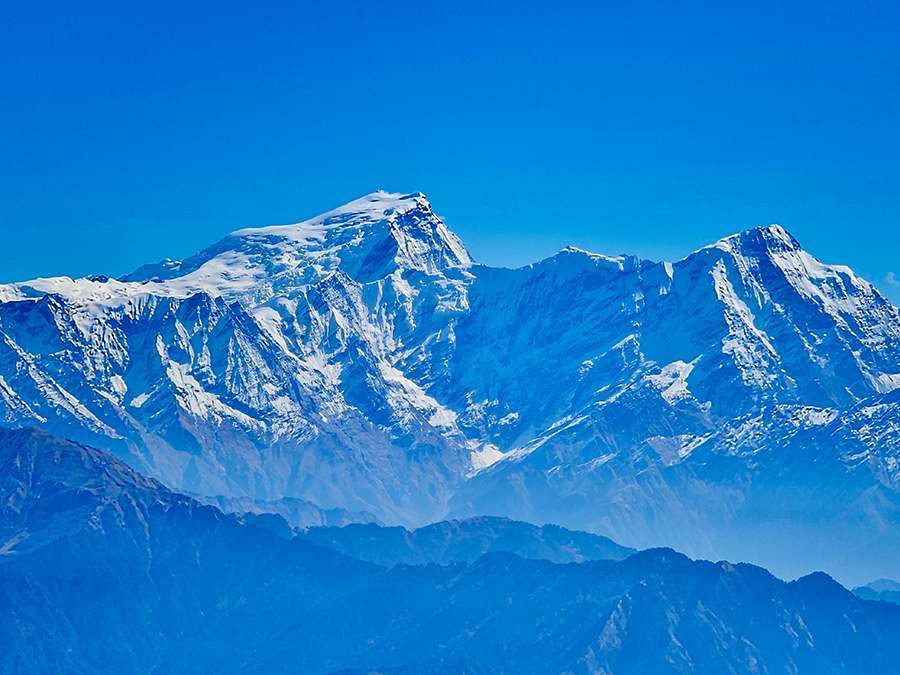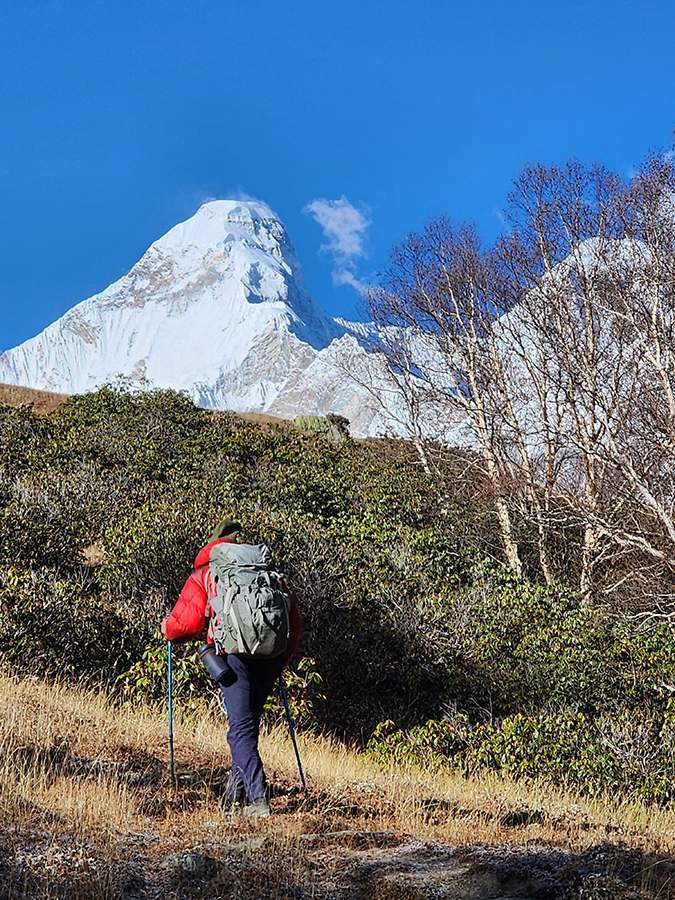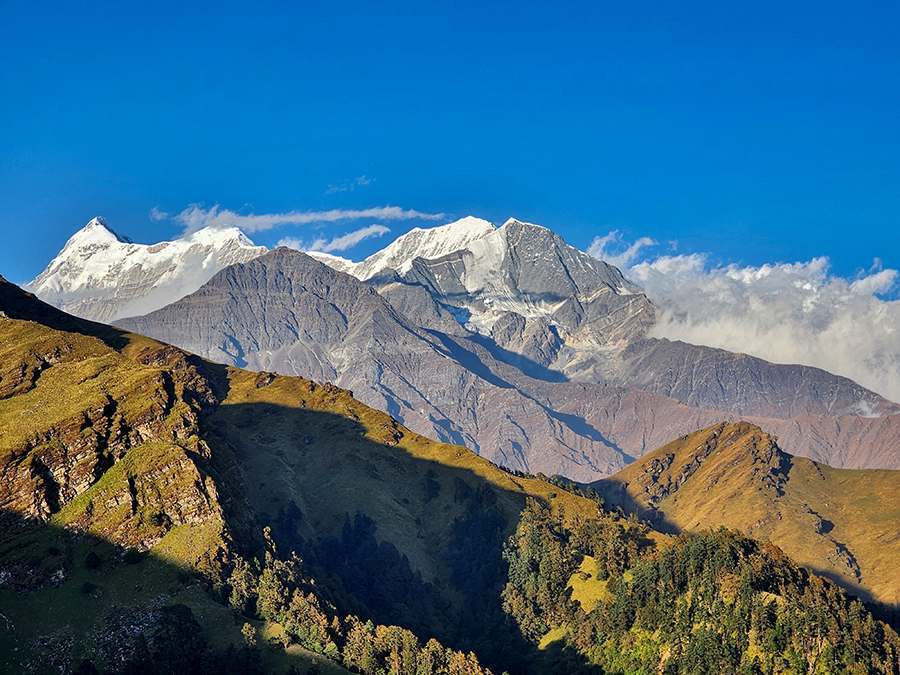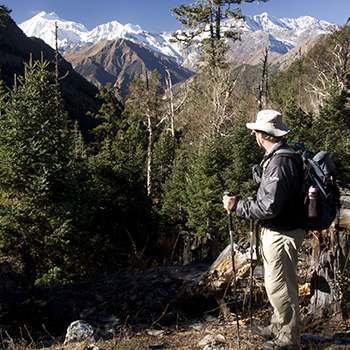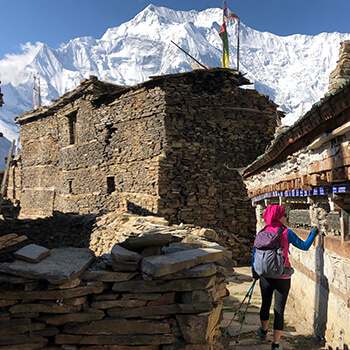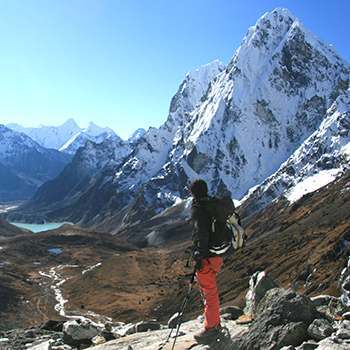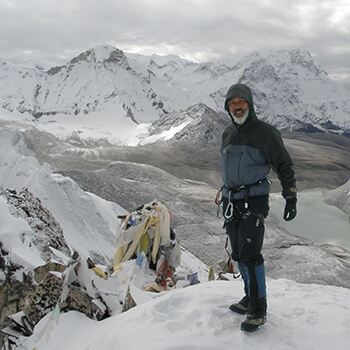
Jasmine’s Indian GHT!
Jasmine’s Trek Across the Indian Himalaya
Flashback: October 13, 2013. As night fell, we walked circles in knee-deep snow to stay warm. Just a few hours before, we had triumphantly stood atop 17,400-foot Rinchen Zoe La, the highest pass on Bhutan’s fabled Snowman Trek. I gave it a three thumbs up! Now 14 of us were lost in a blizzard, overtaken by the remnants of Cyclone Phailin. Our horses, camp, tents, and kitbags were nowhere to be seen, nor was the trail. Even though we were just an hour or two behind the horses, snow was falling so heavily that it filled their tracks—and then some. Our Western guide was about a mile back, building a snow cave to shelter an exhausted member who couldn’t go on. Our local guides were ahead, desperately seeking camp. Our feet were wet from inadvertently walking through a shallow lake, and the only warm clothes we had with us were those in our daypacks. How we ended up in that situation is a story for another day. For now, I’ll just say that when I got home, I declared, “I will never, ever, ever, ever go trekking again!”
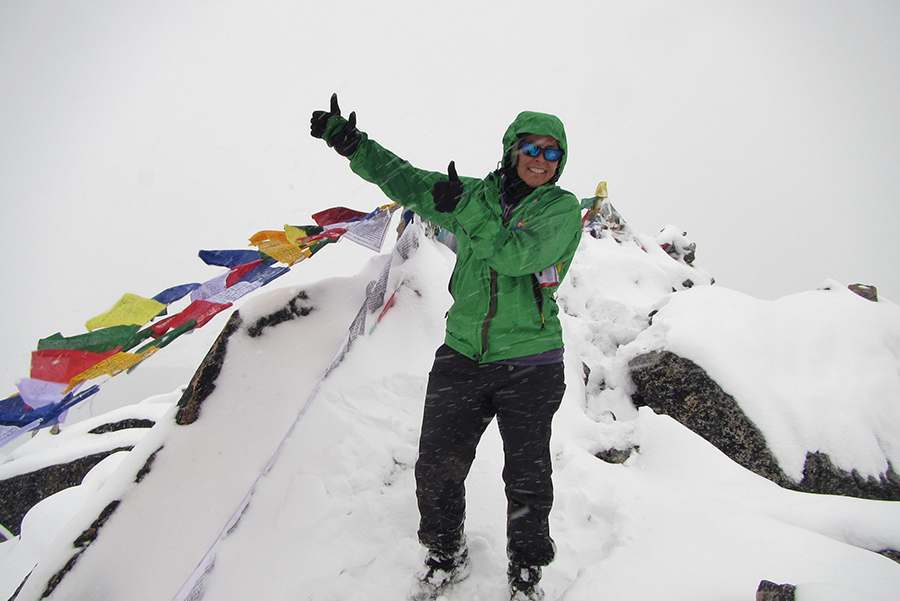
Never Say Never Again
Fast forward a decade, and somehow I’ve ended up wandering across a good portion of the Himalaya: I traversed the Nepal GHT (2016 and 2019), did two long treks in Ladakh (2018), and completed a partial circuit of Nanga Parbat (2022). Beyond the Himalaya, I also did several treks in the greater ranges in Afghanistan and Tajikistan (2017) and Pakistan (2022). But those too are stories for another day. All of those treks are shown in turquoise on the second map. Right now, I’m eager to share my 2023 experience on an inaugural trip across the Indian Himalaya with White Magic Adventure Travel (https://whitemagicadventure.com/the-great-himalayan-traverse-india). Those routes are shown in green on the map.
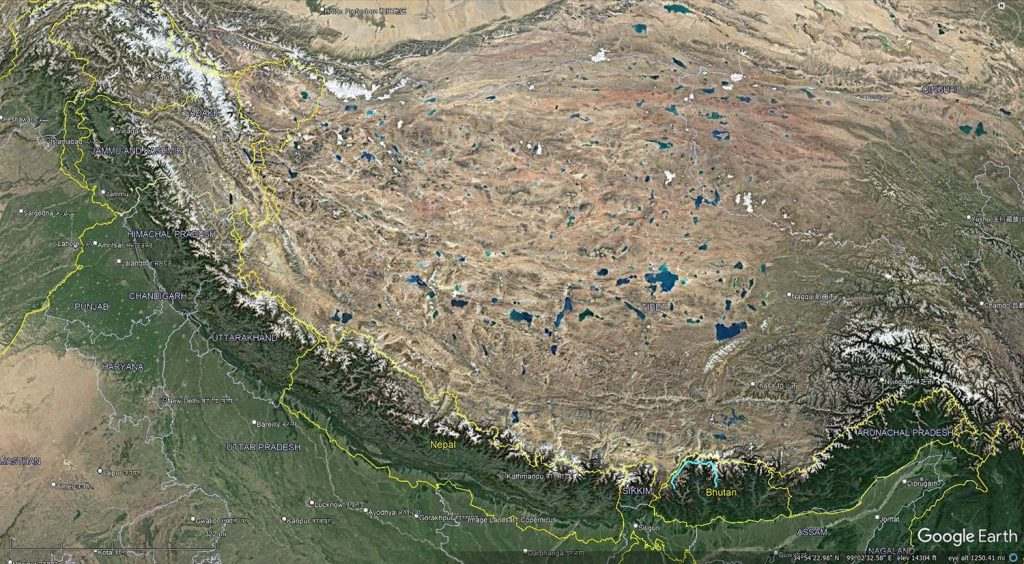
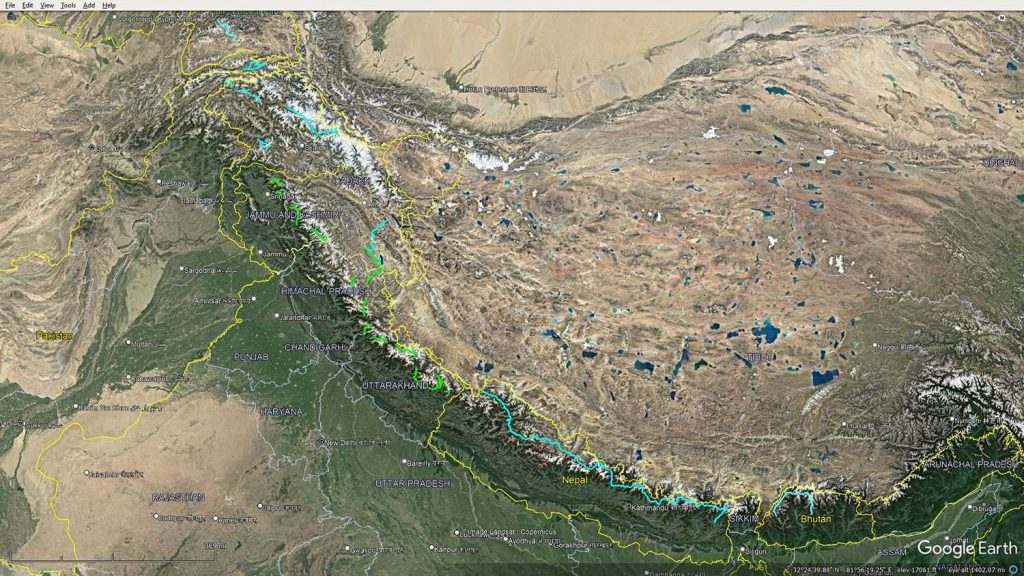
I was fortunate that, back in about 2019, a friend put me in touch with White Magic. Avilash, one of the founders of the company, had long dreamed of offering a traverse of the Indian Himalaya. And thanks to White Magic’s in-depth, on-the-ground knowledge, I believe they are in the best position to design and offer successful treks in this amazing and relatively unvisited region. Their wealth of knowledge also allows them to nimbly move to plan B, or even plan C (D, E), when necessary—a crucial skill on any long-distance venture, especially in a region as dynamic as the Himalaya.
Few Footsteps to Follow
But enough backstory. We’d all rather be trekking, right? White Magic’s India GHT is divided into six sections: Kashmir, Ladakh, Himachal Pradesh, Garhwal, Kumaon, and Sikkim. (Because Sikkim lies far to the east, I decided to save it for a future trek.) The diversity of landscapes and experiences across the regions I traversed was astonishing. Experiencing ever-changing landscapes is what I love best about long-distance hiking, and it’s something I enjoyed every step of the way on the 149-day, 750-mile trip (with 200,000 feet each of elevation gain and loss). When I was doing research for this article, I tried to find other resources on India GHT treks and attempts. A few private parties have put together routes, but only a handful of people have attempted a traverse, most of them back in the 1980s and 1990s. In 2011, Robin Boustead, who created the visionary Nepal GHT route, did a traverse of the northwest Indian Himalaya, forging a route that others might follow. Unfortunately, the time had apparently not yet come for India in the way it had for Nepal.
There’s no way I can give a feel for the entire five-month journey in this short article, so I’ll just offer a few highlights from each section.
Kashmir
Politically embattled Kashmir is renowned for its expansive river valleys and lush green meadows set against a backdrop of enticing snow peaks. Unfortunately, in 2023 late spring snows blanketed the region, persisting well into June. We traversed this section for 39 days, and we faced at least a day or two of challenging snow conditions during each subsection. I was so grateful to be traveling with a company that could shift logistics quickly and seamlessly to accommodate the unseasonable conditions.
- On June 16, we crossed snowbound 13,900-foot Gadsar Pass with a family of nomads and their flock of hundreds of sheep and goats. Our combined party was the first to cross the pass that spring.
- On June 29, descending the rarely visited Lower Zaj Nai Valley in the Kishtwar region, we crossed the raging river time and again on snow bridges that, fortunately, were much stronger than I’d imagined. And thank goodness for those snow bridges! We could not have made the final (and mandatory) river crossing without them.
- In southeasternmost Kashmir, we ascended gorgeous Paddar Valley (also in Kishtwar). We were headed for 18,000-foot Poat La, where we would cross into Ladakh. Unfortunately, a late-season storm buried the pass in snow. Ultimately, and regretfully, on July 15 we chose to turn around just a few hundred feet from the pass and, for safety’s sake, descend the 50-miles we had climbed over the past week.
Ladakh
Our misadventure at Poat La cut into the planned itinerary for Ladakh, a high-altitude desert that lies on the fringes of several border disputes. It’s a stunning land of vast vistas and bare-bones geology. I was sorry that that my time here was whittled down to just 12 days. However, Ladakh is the only region of India I’d visited previously, doing two wonderful long-distance treks here in 2018 with Kamzang Journeys (kamzangjourneys.com/).
- The high point was crossing 15,400-foot Parang La on August 5. We started shortly after midnight so we could climb the steadily steepening glacier to the top while the surface was firm(ish). For this section, horses were carrying our gear, and they performed admirably almost to the top, where steep ice barred their way. No problem! Our crew set to work building a trail for the last few yards so the horses could reach the summit.
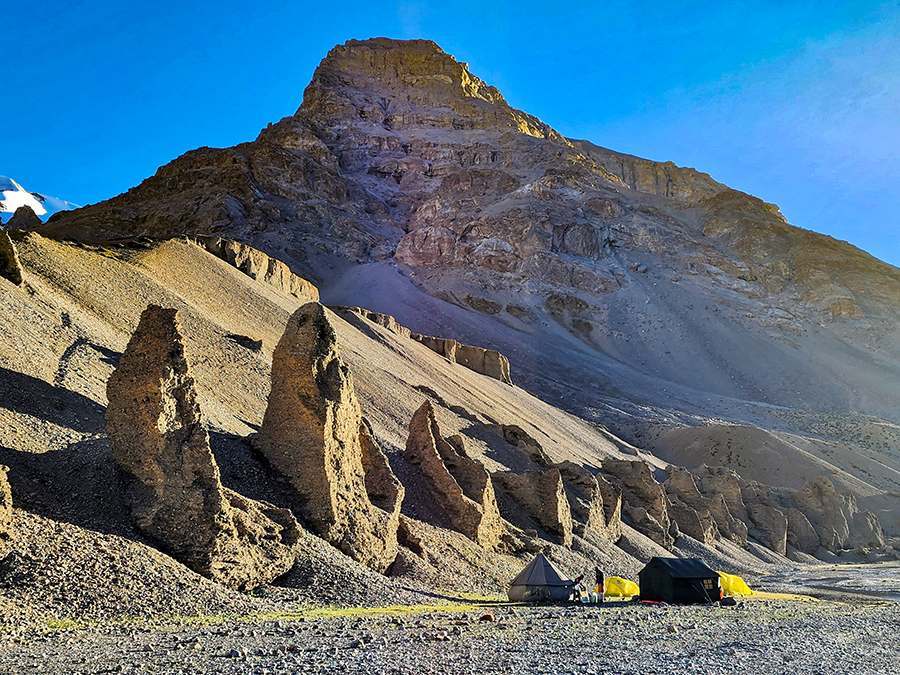
Himachal Pradesh
The name Himachal Pradesh means “the land in the lap of the snowy Himalaya” (or so Wikipedia says). But as it turned out, we hardly experienced any snow during our three weeks in this region. That didn’t mean it was easy or straightforward. This area was hit by torrential rainstorms in the early summer of 2023. Those storms led to landslides, washed-out trails, destruction of bridges, and, tragically, dozens of deaths. We had to forego plan A because portions of the trail and its seasonal bridges had been washed away. Then we had to give up plan B because a bridge on the access road had been heavily damaged. So we went with plan C.
- For plan C, we set out to explore the Bara Shigri Glacier, the third-largest in India, with its own Concordia.
- Unfortunately, the weather wasn’t done with Himachal Pradesh yet. On August 14, we spent an uncomfortable morning stuck in our tents as incessant rain was funneled into continuous debris flows on the steep moraine walls opposite our well-chosen campsite. Finally, a break in the rain gave us a chance to dry out and repitch our tents—one of them threatened by a rapidly rising ephemeral pond.
- After retreating from the Bara Shigri, we moved to plan C: exploration of other nearby mountains and, on August 21, a visit to Chandra Tal, a stunning high-altitude lake.
Garhwal
Of our entire India GHT route, the landscapes in the Garhwal Himalaya are probably the most challenging in terms of terrain underfoot. During the three weeks we traversed the Garhwal, we traveled mostly on glaciers and rocky, unstable moraine. We also saw some of the most dramatic mountain landscapes and, between them, some of the most sacred Hindu pilgrimage sites, including Gangotri, Gaumukh, and Badrinath.
- On September 8, we camped at the foot of 17,000-foot Dhumdhar Khandi before crossing the pass.
- On September 17, we traveled up the aptly name Chaturangi Glacier (“four-color” glacier), en route to the highest pass of the journey.
- On September 22, we crossed 19,300-foot Kalindi Khal. Our acclimatization schedule had been so excellent (thank you White Magic!) that I hardly felt the altitude—not that I was sprinting to the top. From the pass, we enjoyed expansive views, including Kamet, the second-highest peak entirely in India.
Kumaon
The final section I did, Kumaon, is known for its steep terrain and thick vegetation. For me, it was the most challenging section in terms of daily effort—so much up and down! It was also the longest, at 42 days. Thank goodness this section came at the end of the trek, when I was feeling fit from everything that had come before. I hadn’t expected it to be so demanding. I also hadn’t expected to see some of the finest mountain views of the trip—a great reward for the effort. While we were in Kumaon, autumn arrived. The leaves changed, then fell, revealing the surrounding mountains more fully, once again covered with snow as they had been in Kashmir five months before.
- On the night of October 8, we camped at Ali Bugyal (meadow), with expansive views of Trisul and other peaks along the southern rim of the Nanda Devi Sanctuary.
- On October 26, we took a side trip up to Nanda Devi East Base Camp to make a closer acquaintance with 25,600-foot Nanda Devi, the highest mountain entirely in India, and one of the most difficult to reach.
- November 11, day 148 and the penultimate day of the trek, we surmounted 12,850-foot Biasi Bhura Pass, where we soaked in views of the Nepal Himalaya, including Api, the highest peak in the far northwestern corner of Nepal. What a sublime way to end the trek!
Change in the Indian Himalaya
The Indian Himalaya is so dynamic on so many levels: geologically, culturally, geopolitically, and more. Our trip was affected by climate disasters a few times. We were the lucky ones; we didn’t have to make a living off this land, just travel through it as best we could. The landscapes are changing: glaciers receding, hillsides collapsing, rivers raging, bridges being swept away. Meanwhile, roads are being pushed into seemingly every corner of the high mountains. Currently, it feels as though the best time to trek in India was a decade or two ago. Since that isn’t possible, the next-best time is now.
Other changes are afoot. The India GHT page on this very website (https://greathimalayatrail.com/destinations/ght-india-treks/) is filled with superlatives and attests that “trekking options here are some of the best across the entire Great Himalaya Range” and “few people trek the remote areas of the India Himalaya.” That’s a winning combination. Yet you’ll also find this caution: “A word of warning: The adventure industry [in India] is the least professional of the Himalayan countries, and there is a pervasive culture of ‘over-promise, under-deliver.’” I believe that dynamic has been changing for a while now. (And I’d be willing to argue that Pakistan is an equally strong contender for the title of least professional.) In any case, I can vouch, 110 percent, that that there is at least one company you can trust with your life, and trust across the board, in the Indian Himalaya: White Magic Adventure Travel (https://whitemagicadventure.com/). Just a brief perusal of their website or Facebook page (https://www.facebook.com/WhiteMagicAdventure) will assure you that they are out in the Indian Himalaya year-round, running treks and climbs that are usually successful and always as safe as any Himalayan venture can be. Just be sure to pack your sense of adventure!
Ultimately, the route I traversed with White Magic in 2023 was fantastic, and this was just their first iteration of the trip. With each passing year, they will fine-tune the route or make wholesale changes if need be, nimbly adapting to this rapidly changing environment as they always do.
As for the future, I still need to traverse Sikkim. And just this morning, I heard that White Magic is working on a route across Arunachal Pradesh. I never dreamed that a route across this remote, far-flung northeastern corner of India would become viable in my lifetime. I hope it happens soon, before my 61-year-old body and 7-year-old titanium hip give out on me!
If you’d like to see more photos from the inaugural India GHT, visit my Facebook page (https://www.facebook.com/JasmineStarOudoorPhotography).
Postscript: October 20, 2023. Ten years to the day after my Snowman Trek ended, I once again found myself lost in the Himalaya at night. An early autumn snow storm had closed our route over 15,600-foot Kaguri Bhel Pass. Now we were trying to find our way down to the nearest settlement: Jimia, a short 4 miles away, but about 6,500 feet down ridiculously steep slopes, increasingly choked with vegetation as we descended. A few of us—me, the trip leader, and four porters—were separated from the main group. As night fell, we saw a flashing light and a fire and thought it must be our camp. Then, as as we neared the site, countless eyes peered out of the night forest, illuminated by our headlamps. Sheep. Hundreds and hundreds of sheep.
We had arrived at a shepherd’s camp. Eventually, I was resigned to spending the night there. Just one problem: the porters in our group had the food and cooking gear, and the guys down in camp had the camping gear but nothing to eat. It was a lose-lose situation. Then, across the fire, I saw new but familiar faces. Three of our porters had come to find us and guide us to camp. Even now, when I look back on that night, I just laugh. (It helps that we didn’t have to withstand a blizzard…) And when I got home, I declared, “I really, really want to go trekking in India again.”



